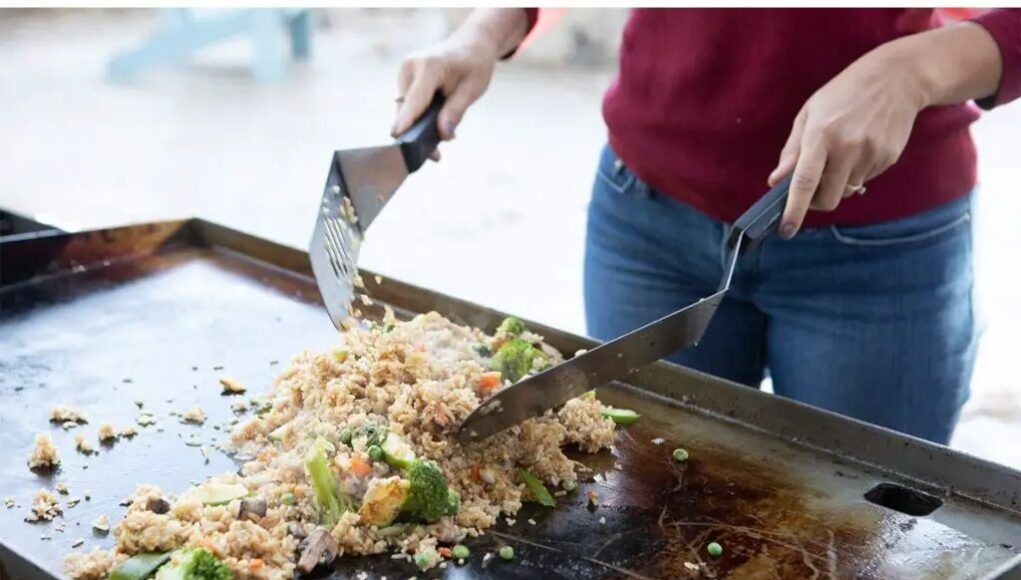Seasoning a carbon steel griddle is a crucial step to ensure its longevity and performance. A properly seasoned griddle not only prevents food from sticking, but also enhances flavor profile over time. In this guide, well dive deep into the best practices and steps required to achieve a perfectly seasoned carbon steel griddle. This guide is tailored to meet the needs of chicken lovers, ensuring that your favorite dishes are cooked to perfection every time.
Before we begin, its important to understand why seasoning is essential. When you first acquire a carbon steel griddle, it lacks the non-stick properties that make cooking enjoyable. Through a process called seasoning, a layer of polymerized oil is formed on the surface, creating a natural, non-stick coating. This not only makes cooking easier but also protects your griddle from rust and wear.

The Importance of Seasoning Your Carbon Steel Griddle
Seasoning your carbon steel griddle is more than just an initial step; its a crucial process that needs maintenance. Here are some key benefits of a well-seasoned griddle:
- Non-Stick Surface: A seasoned griddle prevents food from sticking, making cooking and cleaning a breeze. This is especially important for chicken enthusiasts who want perfectly cooked chicken every time.
- Enhanced Flavor: Over time, a seasoned griddle develops a unique flavor profile that enhances the taste of your dishes.
- Rust Prevention: The oil layer formed during seasoning protects the griddle from moisture and rust.
- Longevity: Regular seasoning extends the lifespan of your griddle, ensuring it remains in top condition for years.

Getting Started: Initial Cleaning
Before you begin the seasoning process, its essential to clean your griddle thoroughly to remove any manufacturing residues or protective coatings. Heres how to do it:
1. Wash with Hot Soapy Water
Use hot soapy water to scrub the griddle. This step removes any factory-applied coatings and ensures a clean surface for seasoning. Be sure to use a scrub brush or sponge to get into all the nooks and crannies.
2. Rinse and Dry
Rinse the griddle thoroughly with hot water to remove any soap residue. Dry it completely with a clean towel or let it air dry. Ensuring the griddle is entirely dry is crucial to prevent rust formation.

Choosing the Right Oil
The type of oil you use for seasoning is essential. Some oils are better suited for high-heat cooking, and you want to choose one that will polymerize properly. Here are some of the best options:
1. Flaxseed Oil
Flaxseed oil is a popular choice for seasoning because it creates a hard, durable layer. However, it can be expensive and hard to find.
2. Canola Oil
Canola oil is widely available, affordable, and effective for seasoning. It has a high smoke point, making it suitable for high-heat cooking.
3. Grapeseed Oil
Grapeseed oil is another excellent option. It has a high smoke point and is known for creating a smooth, non-stick surface.
Step-by-Step Seasoning Process
Now that your griddle is clean and youve chosen your oil, its time to start the seasoning process. Follow these steps for best results:
Step 1: Apply a Thin Layer of Oil
Using a paper towel or a clean cloth, apply a thin, even layer of your chosen oil to the entire surface of the griddle. Make sure to coat the edges and any corners thoroughly.
Step 2: Heat the Griddle
Place the griddle on your stovetop or in your oven. Heat it on medium to high heat until the oil begins to smoke. This step is crucial as it allows the oil to polymerize, creating the non-stick layer.
Step 3: Repeat the Process
Let the griddle cool down before applying another thin layer of oil. Repeat the heating process. For best results, repeat this cycle 3-4 times.
Maintaining Your Seasoned Griddle
Once your griddle is seasoned, maintaining it is crucial to ensure its longevity and performance. Heres how to care for your seasoned carbon steel griddle:
1. Clean Gently
Avoid using soap or abrasive scrubbers on your seasoned griddle. Instead, use a soft cloth or brush and hot water to clean it after each use. This preserves the seasoning layer.
2. Apply a Light Coat of Oil
After cleaning, apply a light coat of oil to the griddle to maintain the seasoning and prevent rust. Use a paper towel to spread the oil evenly across the surface.
3. Store Properly
Store your griddle in a dry place to prevent moisture exposure, which can lead to rust. If possible, keep it in a dedicated spot in your kitchen to avoid damage.
Common Mistakes to Avoid
Seasoning a carbon steel griddle is straightforward, but there are some common mistakes to avoid:
1. Using Too Much Oil
Applying too much oil during seasoning can lead to a sticky residue. Always use a thin, even layer of oil.
2. Skipping the Heating Process
Heating the oil is essential for polymerization. Skipping this step will result in ineffective seasoning.
3. Neglecting Maintenance
Regular maintenance is crucial for keeping your griddle in top condition. Dont neglect cleaning and reapplying oil as needed.
FAQs
Q1: How often should I season my carbon steel griddle?
A1: Its recommended to season your griddle initially and then maintain it by applying a light coat of oil after each use.
Q2: Can I use my seasoned griddle for any type of cooking?
A2: Yes, a well-seasoned griddle can be used for a variety of cooking methods, including grilling, frying, and sauting.
Q3: What should I do if my griddle starts to rust?
A3: If rust appears, scrub the affected area with a brush and re-season the griddle by applying oil and heating it.
Conclusion
Seasoning your carbon steel griddle is an essential step to ensure its longevity and performance. By following the steps outlined in this guide, you can achieve a well-seasoned griddle that enhances your cooking experience, especially for chicken lovers. Remember, regular maintenance is key to keeping your griddle in top condition. Happy cooking!
For more detailed guidance on griddle seasoning, check out this external resource.
As an Amazon Associate, I earn from qualifying purchases.
As an Amazon Associate, I earn from qualifying purchases.








